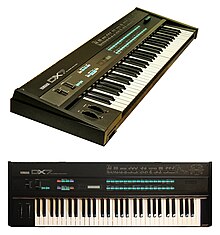یاماها دیایکس۷ - ویکیپدیا، دانشنامهٔ آزاد
| Yamaha DX7 | |
|---|---|
 | |
| تولیدکننده | یاماها |
| تاریخها | 1983–1989 |
| قیمت | US$1,995 UK£1,495 JP¥248,000 |
| خصوصیات فنی | |
| چندصدایی | 16-voice |
| رنگآمیزی | Monotimbral Bitimbral (DX7 II) |
| نوسانساز | 6 sine wave operators per voice, 32 algorithms |
| نوع سنتز | Digital linear frequency modulation / Additive synthesis (alg. #32) |
| فیلتر | none |
| تضعیفکننده | 1 pitch envelope & 6 amplitude generators per voice |
| ابراز پس از لمس | Yes (channel) |
| ابراز شتاب | Yes |
| حافظهٔ ذخیرهسازی | 32 patches in RAM (battery backup); front panel ROM/RAM cartridge port |
| افکتها | none |
| سختافزار | YM21280 (OPS) operator chip YM21290 (EGS) envelope generator |
| ورودی/خروجی | |
| صفحهکلید | 61-note with velocity and aftertouch sensitivity |
| کنترلهای سمت چپ | pitch-bend and modulation wheels |
| کنترلهای خارجی | Midi in/out/thru, input for foot controller x2, input for foot switch x2, input for optional breath controller |
یاماها دی ایکس۷ سینثسایزری بود که توسط شرکت یاماها از سال ۱۹۸۳ تا سال ۱۹۸۶ تولید میشد. این ابزار اولین سینثسایزر دیجیتال موفق تجاری شد. صدای آن میتوان در آثار ضبط شده فراوانی از دهه ۸۰ میلادی شنیده شود. دی ایکس۷ مدلی با قیمت متوسط از سری کیبوردهای اف ام بزرگ شامل دی ایکس۹، دی ایکس۱۰۰، دی ایکس۱۱ کوچکتر و دی ایکس۱، دی ایکس۵ بزرگتر بود. بیش از تعداد ۱۶۰،۰۰۰ عدد از آن ساخته شد.
ابزار فوق بر پایه سنتز مدولاسیون فرکانس اف ام ساخته شده بود و بر اساس پژوهش جان چاونینگ از دانشگاه استنفورد شکل گرفته بود. دی ایکس۷ بخاطر دقت و انعطاف پذیری در وضوح آن شناخته شده بود و مقدم بر سینثسایزرهای آنالوگ مشابه خود بود. دی ایکس۷ بخاطرصدای پیانوی الکتریک، ناقوسها و دیگر صدای سابیده شدن فلز روی فلز بسیار معروف بود. این سینثسایزر تک آوایی قادر به پخش پلی فونیک ۱۶ نتی بود، ۳۲ الگوریتم داشت که هر یک میتوانست چیدمان متفاوتی داشته باشد و به استفاده کنتدهاش اجازه میداد تا ۶ اپراتور صدا را به صورت مستقل یا غیرمستقل باهم درآمیزد.
منابع
[ویرایش]- ↑ "{{جا:PAGENAME}}". History, Yamaha Synth 40th Anniversary. Yamaha Corporation. 2014.
At that time, a number of Yamaha departments were developing different instruments in parallel, ... the direct forerunner of the DX Series synths was a test model known as the Programmable Algorithm Music Synthesizer (PAMS). In recognition of this fact, the DX7 is identified as a Digital Programmable Algorithm Synthesizer on its top panel. / As its name suggests, the PAMS created sound based on various calculation algorithms—namely, phase modulation, amplitude modulation, additive synthesis, and frequency modulation (FM)—and from the very start, the prototype supported the storing of programs in memory. However, this high level of freedom in sound design came at the price of a huge increase in the number of parameters required, meaning that the PAMS was not yet suitable for commercialization as an instrument that the average user could program. / In order to resolve this issue, the Yamaha developers decided to simplify the synth's tone generator design by having the modulator and carrier envelope generators share common parameters. They also reduced the number of algorithms—or operator combination patterns—to 32.


 French
French Deutsch
Deutsch